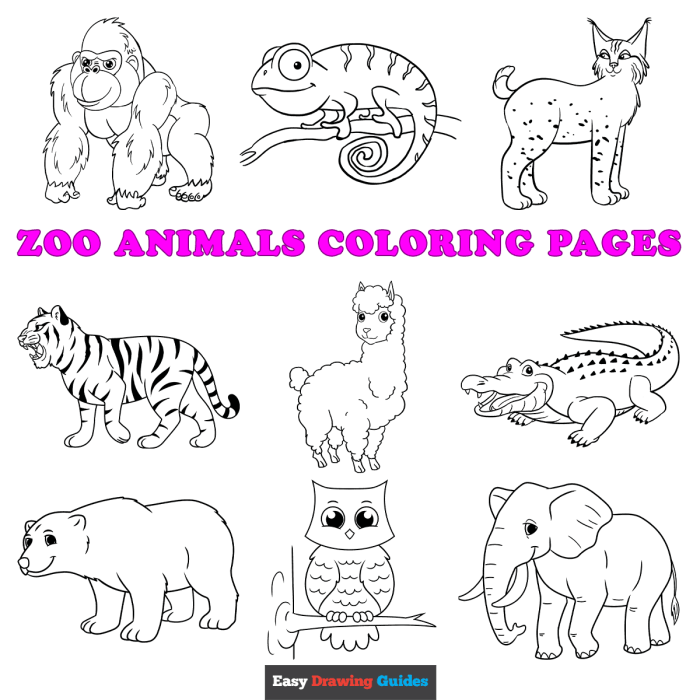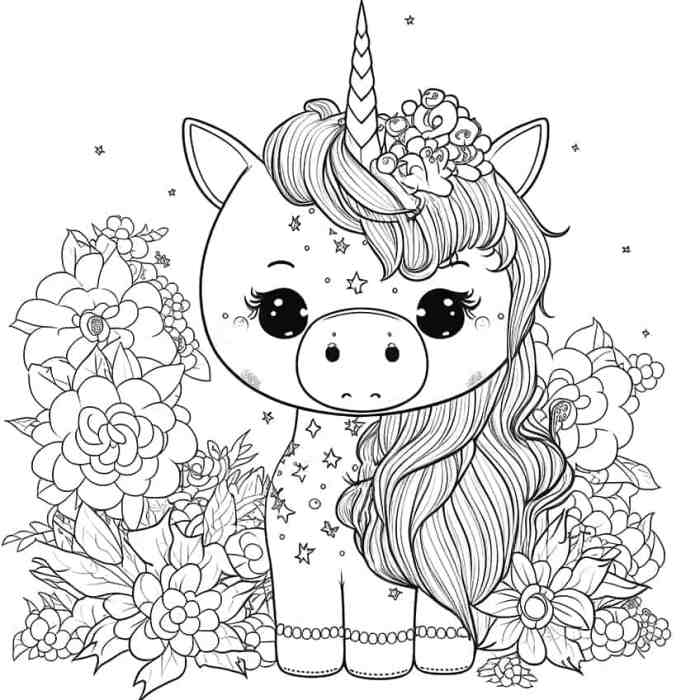Popularity and Trends: Animals Clipart For Coloring

Animals clipart for coloring – Animal coloring pages enjoy widespread popularity online, serving as a relaxing and creative outlet for people of all ages. Their accessibility and versatility contribute significantly to this enduring appeal, with readily available resources catering to diverse interests and skill levels. The digital realm has amplified this popularity, offering instant access to countless designs and fostering a vibrant community of artists and enthusiasts.
Current Popularity of Animal Coloring Pages Online
The popularity of animal coloring pages online is substantial and readily observable across various platforms. Websites dedicated to printable coloring pages often feature animal themes prominently, alongside social media platforms like Pinterest and Instagram, which showcase numerous user-generated content featuring completed animal coloring pages. The consistent high search volume for “animal coloring pages” on search engines further underscores the enduring demand for this type of content.
This popularity is driven by factors such as stress reduction, creative expression, and the simple enjoyment derived from the activity. The ease of access through online platforms contributes significantly to this widespread appeal.
Emerging Trends in Animal Clipart Design for Coloring
Three notable trends are shaping the evolution of animal clipart design for coloring. Firstly, there’s a growing preference for intricate and detailed designs, moving beyond simple Artikels to incorporate complex patterns and textures. Secondly, the incorporation of mandalas and other geometric patterns within animal forms is becoming increasingly popular, creating visually striking and engaging designs. Finally, a rise in popularity of designs featuring endangered or lesser-known animals is evident, raising awareness about conservation efforts and promoting appreciation for biodiversity.
Popularity of Different Animal Types in Coloring Page Clipart
Mammals consistently rank highly in popularity, with designs featuring cats, dogs, bears, and other charismatic megafauna dominating the market. Birds, particularly those with vibrant plumage like parrots and peacocks, also enjoy significant popularity. Reptiles, while less prevalent than mammals and birds, are gaining traction, especially designs featuring snakes, lizards, and turtles, often incorporating intricate scales and patterns. The popularity of specific animal types often reflects cultural trends and seasonal influences, with certain animals gaining prominence during specific times of the year.
For instance, designs featuring owls might see increased popularity around Halloween.
Historical Evolution of Animal Coloring Page Styles, Animals clipart for coloring
| Decade | Style | Popular Animals | Notable Artists (Illustrative Examples) |
|---|---|---|---|
| 1950s-1960s | Simple line drawings, often found in children’s books | Common domestic animals (cats, dogs), farm animals | Many anonymous illustrators in children’s books; specific attribution is often difficult |
| 1970s-1980s | More detailed illustrations, sometimes incorporating color within the lines | Expanding range of animals, including wild animals and fantasy creatures | Again, largely anonymous, though specific artists tied to popular children’s book series might be identified |
| 1990s-2000s | Increased use of computer-aided design; wider variety of styles, including realistic and cartoonish depictions | Diverse range of animals, influenced by popular culture and animation | Emergence of digital artists and illustrators; specific attribution becomes more common |
| 2010s-Present | Intricate designs, mandalas, realistic styles, focus on detail and texture; digital art is dominant | Wide range, including endangered species and mythical creatures; reflects broader societal interests | Many independent digital artists and illustrators active online; collaborative projects are more common |
Artistic Styles and Techniques

Creating visually appealing and engaging animal coloring pages requires a thoughtful approach to artistic style and technique. The choice of style significantly impacts the final product’s aesthetic and the target audience’s engagement. Different styles cater to varying preferences, from the meticulous detail of realism to the playful simplicity of cartoons. Understanding these styles and employing effective techniques is crucial for designing successful coloring pages.
Children often enjoy the simplicity of animals clipart for coloring, allowing for creative expression and basic skill development. However, exploring the intricacies of biology can be equally engaging, and a great next step might be delving into the fascinating structures revealed by animal eukaryotic cell coloring. This allows for a deeper understanding of the building blocks of life, providing a more complex, yet still visually appealing, coloring activity compared to simple animal clip art.
Realistic vs. Cartoonish Animal Clipart
Realistic animal clipart strives for accurate representation of animal anatomy, fur texture, and coloration. Details are meticulously rendered, aiming for a photorealistic effect, even within the constraints of a line drawing. Cartoonish clipart, conversely, simplifies features, often exaggerating proportions for comedic or expressive effect. Lines are typically bolder and simpler, focusing on conveying character and emotion rather than anatomical accuracy.
A realistic lion coloring page might showcase individual strands of mane hair and the intricate details of its muscular structure, while a cartoonish lion might have simplified, round features and exaggeratedly playful expressions.
Examples of Artistic Styles in Animal Coloring Pages
The selection of artistic style significantly influences the overall feel and appeal of an animal coloring page. Five distinct styles, each with unique characteristics, are detailed below:
- Line Art: This style utilizes clean, precise lines to define the animal’s form. It often lacks shading or complex details, focusing on the Artikel and basic shapes. Think of simple, black-and-white drawings, perfect for younger children.
- Watercolor: This style evokes a soft, delicate feel. Animals are depicted using washes of color, allowing for subtle gradations and blending. The lines may be less defined, creating a more fluid and impressionistic look. Imagine a whimsical bunny with soft, blended pastel colors.
- Zentangle: This style incorporates intricate patterns and doodles within the animal’s Artikel. It’s a great way to add complexity and visual interest, making the coloring process more engaging for older children and adults. Picture a majestic peacock with its feathers filled with elaborate, repetitive patterns.
- Manga/Anime: This style features large, expressive eyes and simplified features, often with exaggerated proportions. Animals are portrayed with a distinct Japanese animation style, appealing to fans of this aesthetic. Think of a cute, wide-eyed fox with stylized features.
- Geometric: This style uses geometric shapes to construct the animal’s form. Instead of curves, straight lines and angles are prominent, creating a modern and stylized effect. Envision a playful elephant composed of triangles and squares.
Techniques for Creating Visually Appealing Animal Clipart
Several techniques can enhance the visual appeal of animal clipart for coloring pages.
- Varying Line Weight: Using thicker lines for Artikels and thinner lines for details creates depth and visual interest. This technique helps guide the coloring process and adds dimension to the drawing.
- Strategic Use of Negative Space: Leaving some areas unfilled allows for visual breathing room and prevents the image from feeling cluttered. Clever use of negative space can enhance the overall composition and make the animal’s form stand out.
- Incorporating Simple Patterns and Textures: Adding simple patterns or textures within the animal’s form, such as stripes, spots, or scales, adds visual richness and complexity without overwhelming the design. This can be as simple as hatching or cross-hatching for fur texture.
Designing an Animal Coloring Page Using Line Art
The process of designing a line art animal coloring page begins with sketching a basic Artikel of the animal. Proportions and posture are established, focusing on capturing the animal’s essence. Once the sketch is finalized, it’s refined using digital drawing software or traditional pen and ink. Clean lines are crucial; inconsistencies in line weight are addressed. Details such as fur texture can be suggested through varying line density and cross-hatching.
Finally, the line art is cleaned up and prepared for printing, ensuring that the lines are bold enough to be easily visible and colored. For instance, designing a line art fox would involve initially sketching the basic shape, then refining the details such as the muzzle, ears, and bushy tail, ensuring clean lines and varying line weights to create depth.
Illustrative Examples

Several coloring page examples demonstrate the versatility and appeal of animal-themed designs. These examples showcase different artistic styles, line weights, and compositional approaches, highlighting the potential for creative expression within this medium. Each design prioritizes clear line art suitable for coloring, while incorporating engaging details to stimulate the imagination.
Playful Monkey Swinging from a Tree
This coloring page features a mischievous monkey swinging playfully from a thick, gnarled tree branch. The monkey is depicted in a dynamic pose, its limbs outstretched, suggesting movement and energy. The line weight is varied, with thicker lines outlining the monkey’s body for emphasis and thinner lines detailing its fur and facial features. Subtle shading is incorporated through varying line density, creating depth and form without overwhelming the design.
The background includes simple, stylized leaves and a suggestion of a sun-dappled forest floor, created using delicate lines and minimal detail to keep the focus on the monkey.
Majestic Lion in a Savanna Setting
A majestic lion, depicted in a regal pose, dominates this coloring page. The lion’s mane is rendered with detailed, flowing lines, creating a sense of volume and texture. The color palette suggested is earthy and warm, utilizing shades of ochre, gold, brown, and tawny for the lion, contrasting with the cooler greens and blues of the savanna. The composition is carefully balanced, with the lion positioned centrally against a backdrop of tall grasses and distant acacia trees.
The line work is clean and precise, with varying line weights used to define form and create visual interest.
Colorful Birds on a Branch
This coloring page showcases a vibrant array of birds perched on a blossoming branch. Three distinct bird species are included: a scarlet tanager, a blue jay, and a yellow warbler, each rendered with characteristic plumage patterns. The birds are arranged in a visually appealing cluster, with slight overlaps to create depth and avoid a static arrangement. The branch itself is detailed with delicate blossoms and leaves, creating a visually rich setting for the birds.
The line weight is consistent, allowing for easy coloring, and the design is overall bright and cheerful.
Whimsical Underwater Scene
This coloring page transports the colorer to a vibrant underwater world. A playful octopus, a friendly sea turtle, and several brightly colored fish populate the scene, alongside swaying kelp forests and coral reefs. The line work is varied, employing softer lines for the flowing kelp and bolder lines for the sea creatures. The overall style is whimsical and fun, with exaggerated features and playful expressions on the animals.
A range of blues, greens, and vibrant coral hues are suggested for coloring, creating a lively and engaging underwater scene. Bubbles are incorporated as small, circular details to add to the sense of movement and depth within the scene.
FAQ Insights
What software is best for creating animal clipart for coloring?
Several programs are suitable, including Adobe Illustrator, CorelDRAW, and even free options like Krita or Inkscape. The best choice depends on your skill level and budget.
Where can I find free animal clipart for coloring?
Many websites offer free animal clipart, but always check the license to ensure permitted use. Creative Commons licensed resources are a good starting point.
How can I sell my own animal clipart for coloring?
Platforms like Etsy and Creative Market allow artists to sell digital artwork. Ensure you understand copyright and licensing before selling your creations.
What are some tips for making my animal clipart designs more appealing?
Consider using varied line weights, interesting compositions, and incorporating subtle details to add visual interest. A well-chosen color palette is also crucial.
